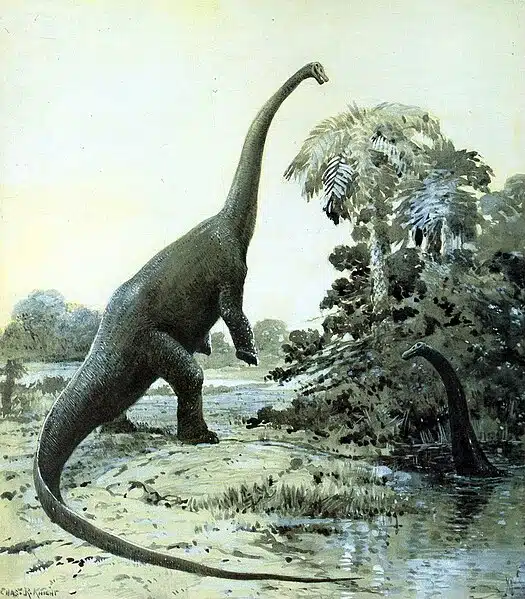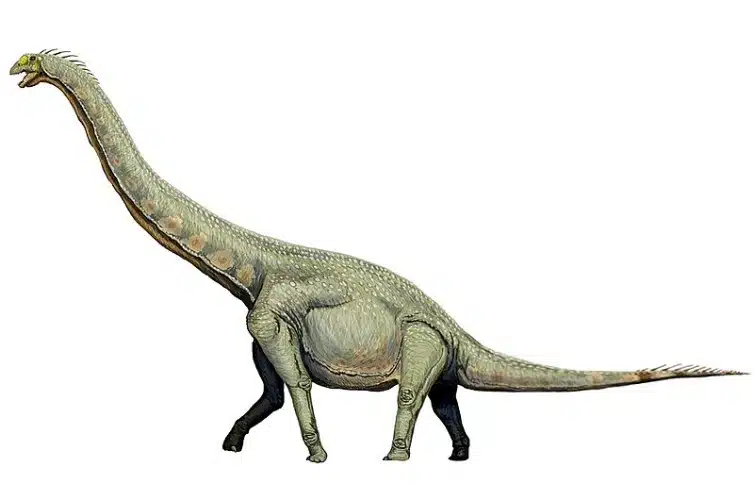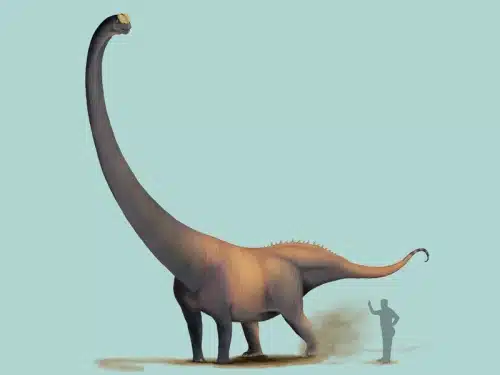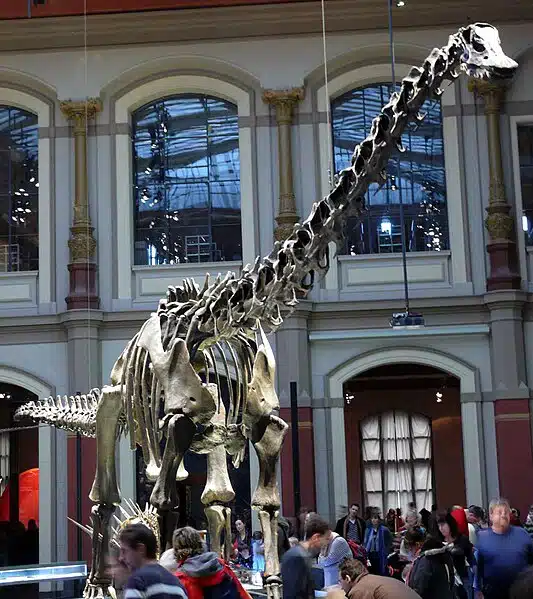Sauropod dinosaurs were the largest terrestrial land animals to ever roam the earth. Not only were they big by standards of individual largeness, but much like cattle in modern ecosystems, they were likely a driver of climatic heating through sheer biomass alone. But how did sauropods get so big? And, possibly more to the point, why did they get so big? Was such gratuitous massiveness really necessary from an evolutionary perspective?
To answer that it is probably best to start from the beginning – right at the very dawn of the Age of the Dinosaurs – roughly 230 million years ago in the late Triassic to be precise.
The Beginning
When we imagine the world of the dinosaurs, most people tend to picture a kind of palaeo-zoo in which ferocious T-rexs chase after spiny-backed stegosaurs while tiny heterodontosaurs cower in the underbrush. However, dinosaurs (well, non-avian dinosaurs to be precise) dominated the planet for 150 million years. With average species turn-over being roughly 5 million years, it stands to reason that not all dinos existed at the same time.

The ancestral dinosaur
So what did the ancestral dinosaur look like? Although it’s difficult isolating the one species ancestral to all later dinosaurs amongst a multitude of similar-ish contenders, a fair general portrait is of a roughly dog-sized critter, scampering about nimbly on two legs, with a longish serpentine neck and long semi-dexterous hands. This animal may have been an opportunistic omnivore, by turns insectivorous or carnivorous depending on what the landscape availed it. Animals like Eoraptor and Chindesaurus are good exemplars of the earliest true dinos.
However, around 220ish million years ago a fundamental split occurred at the base of what we call saurischian dinosaurs, with one branch committing to a fully carnivorous diet, ultimately becoming the star-studded cast of velociraptors and tyrannosaurs known as Theropoda. The other branch took a very different route altogether, taking a chance on a plentiful but much less nutrient-heavy food source – plants.
The shift to plants
The first herbivorous saurischians—what we’ll call “prosauropods” but in technical lingo are generally referred to by the snappy title of basal Sauropodomorpha—were a kind of husky play on the same body plan inherited from that ancestral dino. Imagine a kind of reptilian giant sloth, standing on two legs while using its hands to manipulate and pull vegetation towards a head affixed atop a long, sinuous neck. The iconic German taxon Plateosaurus is a good example of the classic “prosauropod”.
This body plan kept prosauropods feeding in good stead for around 20-odd million years up until the outset of the Jurassic 200 million years ago. However – the limits of this feeding strategy soon began to make themselves known.
Too big to stand (upright)
Early on, the shift to a fully vegetarian diet was likely aided by the retention of a bipedal posture, which in concert with the long neck and mobile grasping hands may have helped the prosauropods access higher vegetation. However, there were several factors—what we might call constraints—at play in the background that made sure this strategy could only go so far.
Teeth
Prosauropods inherited a set of chompers not radically different from their proto-dinosaurian forebearers. These pencil-like teeth, similar to that adorning the mouths of many of today’s lizards, might have been good for snapping up the odd critter that strayed into their path, but they were woefully inept at performing a task that every human takes for granted: chewing.
Don’t underestimate the benefits of chewing your food in advance of swallowing it. Chewing food breaks it into smaller particles, increasing the surface area relative to the mass, allowing stomach enzymes more purchase to work their digestive magic. This lack of chewing is less of an issue when your daily intake consist of high energy foods like meat. But what do you reckon the average energy quotient of a conifer leaf is? Not particularly high, is what.
Stomach
This then naturally leads us to the next logical point along the alimentary road – the stomach. More specifically, the stomach of a multi-tonne bulk-browser that can’t chew its food.
Think of one of the larger mega-herbivores alive today: the humble cow. Cows subsist almost entirely on a diet of fibrous, low-nutrient grasses. Much of a cow’s largeness comes from the sheer size of their gastrointestinal tract, which is broken up into multiple chambers to aid in digestion of tough, fibrous foodstuffs. And this for an animal that still chews its food in advance!
Now imagine the stomach of one of our larger prosauropods – which is better conceived of less than a stomach than as a giant fermentation chamber in which microbes were left to do pretty much all the heavy lifting re the conversion of food into energy. In order to reach their daily energy requirements, these animals would have needed to consume a lot of plant matter, which would have required a concurrently large stomach with which to process all of it.
And here we have it – a classic feedback loop: the larger the animal became the more food it required, the more food it required, the larger the stomach needed to be in order to process it.
Gravity
This was the final straw that broke the prosauropod’s upright back, so to speak. The centre of mass of most dinosaurs was located over their hips. As the prosauropod stomach got larger, it shifted this centre of mass forward, making the task of walking around on the hindlegs alone increasingly onerous. So, sometime in the early Jurassic around 195 million years ago, what we can now call true sauropods threw their hands up (or down) and committed to a locomotory mode they’d maintain through to their extinction some 130 million years later – quadrupedality.
Sauropods: the true giants

The story doesn’t stop with the transition to a fully quadrupedal gait, however. The first true—what we might call obligate—quadrupeds weighed around 6-8 tons, comparable to a modern elephant in size. However, the largest sauropods—animals like Argentinosaurus—weighed upwards of 80 tons. This suggests that once the forelimbs had been coopted specifically for walking-upon, the floodgates holding back true gigantism were thrown well and truly open.
But what additional factors were at play in this headlong drive towards continuing bigness?
Gigantism cascade
Gigantism was less the outcome of a number of novel innovations and more a perfect coalescence of primitive and not-so-primitive traits that, once they came together, seemed to all but guarantee a massive jump in body size. This phenomenon, which palaeontologists have referred to as an evolutionary cascade, created a unique scenario in which sauropods were constrained only by the biophysical laws of how big a land animal is “allowed” to become.
We’ve already discussed some of the more primitive – but what about those adaptive tweaks to the primitive condition that paved the path to titan-hood?
Columnar limbs
Most living “reptiles” walk on splayed limbs that extend outwards from the body. One of the great dinosaurian innovations was the evolution of hindlimbs held directly underneath the body. This allows for a much safer, more stable distribution of weight, and is pretty much a prerequisite for any terrestrial animal that wants to attain some modicum of “bigness”. Sauropods took this even further by forcing the forelimbs into a very similar, columnar posture as the hindlimbs—a feature that no other dinosaurian quadrupeds evolved. Animals like Tazoudasurus from the Early Jurassic of Morocco are a good exemplar of the earliest true, comunar-limbed sauropods.
Pneumaticity
Birds have a unique, unidirectional respiratory system that allows for super-efficient flow of oxygen around the body. Based on the hollows and pockets preserved within their vertebrae, we know that a similar system of pulmonary air sacs was present in sauropod dinosaurs – likely inherited in incipient form from their common dinosaurian ancestor with birds.
In addition to efficient respiration as larger sizes, there were other advantages of this system:
Heat dissipation
All evidence now points to dinosaurs having been endothermic (warm blooded), much like mammals. Because body heat scales with body size, one of the mysteries of how sauropods got so big is how they managed to stop overheating. The math behind this is simple: the larger your body mass the larger your internal volume is relative to the surface of your body, essentially making it harder for heat to escape. Large mammals like elephants have devised a bit of an evolutionary work around to this problem through the evolution of their large flappy ears – allowing them to increase body surface without adding to their appreciable mass. But what about sauropods? They certainly didn’t have large flappy ears.
While the famously long neck probably contributed to a modest increase in relative body surface, some scientists now argue that the efficient avian-style respiratory system also helped better regulate heat around the body.
Weight reduction
This one is a bit of a no-brainer. Invasive air-sacs that formed pneumatic “pockets” within the bones themselves would have also helped lighten the skeleton, allowing for larger bones relative to animals with denser, non-air-sac-invaded vertebral columns. With most of these air sacs concentrated within the cervical (neck) vertebrae, this pneumaticity would have gone a long way towards making that central feeding apparatus all the more manoeuvrable…
Sauropods: Sticking their neck out
And on that note, we move onto the most familiar part of the sauropod anatomy, their famously elongate neck. Although a fairly long neck was present in the earliest dinosaurs, sauropods took it to a whole new extreme, with some species of Mamenchisaurus sporting necks over 12 meters in length! Let’s take a moment to really break down what the sauropod neck was: a long, flexible tube that ended in tooth-lined hole. If those teeth were intended to do anything other than rake unchewed vegetation off the branch, then the skull required to support them would have likely been too heavy for such a spindly neck. Hence the primacy of those retained primitive features in building a sauropod.

Increasing the feeding envelope
But what were the true advantages? Obviously, when most people look at the sauropod neck they logically assume that longer neck = higher reach = more food. But was it really that simple? Most palaeontologists now reconstruct the average sauropod neck as held roughly horizontal with the ground. Although some degree of upward mobility was likely possible, it was probably rather energetically demanding to hold that posture for extended periods – especially if you take efficient bipedal rearing out of the equation.
Instead we can picture the neck as a kind of low-angled crane – a sweeping feeding vacuum that allowed sauropods to access as much forage as possible while standing on the spot. This meant they could browse without having to move their great baulk around more than was absolutely necessary—an energy-saving scheme that perhaps more than any other accounts for the unprecedented size of sauropod dinos.
Survival in the Mesozoic
As we have seen, gigantism in sauropods is best explained as a charmed collection of mostly primitive features that when combined with the shift to herbivory and a quadrupedal gait set them on the path to gianthood.
Giant size came with a host of obvious advantages, not least an adult body size that made them near-impervious to predation from their theropodan cousins. They were hardly born gigantic, however, with the size of hatchlings limited by the structural constraints of the humble eggshell. In this regard, sauropods appeared to have benefited by a “hands-off” approach to parenting, with masses of eggs laid in a single clutch before being left to fend for themselves. This (let’s call it the “sea-turtle”) approach to parenthood likely resulted in most of the hatchlings being gobbled up in a theropod feeding frenzy before they could make the safety of the underbrush. For those lucky few that survived, they were at least aided by the final evolutionary novelty pivotal to building a sauropod:
Increased growth rates
If sauropods grew at the same rate as their (very distant) crocodilian relatives, it would take the better part of a century to reach adult size. However, studies of the microanatomy of sauropod limbs shows that they grew at a rate closer to mammals, with adult size possibly achieved by 30 years. Advanced growth rates were possibly present in the earliest dinosaurs and may have been amplified even further in Sauropoda as part of an evolutionary arms race with theropod dinosaurs. While the latter was clearly more restricted with respect to overall body size, larger predators meant larger prey, and it would have certainly benefited a fledging sauropod to quickly test any natural notions of what “large” really meant.
Who’s who of Sauropodas

As we have seen, sauropod dinosaurs were the result of a series of tweaks to a primitive dinosaurian body plan that was surprisingly predisposed to building a megaton bulk browser. This body plan stood sauropods in good stead for well over 100 million years, making them one of the most successful group of terrestrial herbivores. Although the “typical” sauropod condition of a long neck supported atop a chassis of four sturdy feet remained relatively unchanged up until their extinction, there were several substantive variations on this theme, with some of the more noteworthy specimens discussed below.
Vulcanodon
Partial remains of this rare dino were recovered from the Early Jurassic (~190mya) of Zimbabwe in the 1960s. To this day it remains the best contender for the earliest “true” sauropod, based mainly on the long, columnar morphology of its fragmentary forelimb material. This suggests that this sauropod was using its forelimbs exclusively for walking upon in the “parasagittal” position. In contrast, other near-contemporaries and contenders for the “first sauropod” crown like Antetonitrus and Lessemsaurus still had laterally flexed forelimbs that likely supported an at least semi-bipedal locomotory habit.
Diplodocus
Fast forward to the late Jurassic and diplodociod dinosaurs are the planet’s most successful and geographically widespread clade of sauropods. Within Diplodocoidea we have the snappily titled subclade of Flagellicaudata, named for their hyper-long “whiplash” tails. One member of this group, Diplodocus—amongst the earliest named and most recognisable of all dinosaurs—represented one of the longest known of all sauropods, with length estimates of over 30m. Although the purpose of the long whiplash tail remains a mystery, with either predator deterrence or intragroup signalling hypothesised, it remains one of the more curious plays on the sauropod design.
Brachiosaurus
The majority of sauropods had forelimbs slightly shorter or subequal in length to their hindlimbs. In concert with a neck that pointed mostly forward, this suggested that breadth of horizontal reach was more important that vertical reach when feeding. Brachiosaurus, with its proportionally long forelimbs and upward curving neck, represented an intriguing exception to the above. Often found in the same Late Jurassic environments as dipolodicoid dinosaurs, this apparent high-browser offers clear evidence of differing feeding strategies and nice-partitioning within Sauropoda.
Alamosaurus
This dinosaur was part of the most successful and long-lived sauropod clades, Titanosauria, which also included the largest of all dinosaurs like Argentinosaurus and Patagotitan. Alamosaurus, which was comparable in size to these 70+ ton giants, is of particular interest as it represents the only known sauropod from North America during the Late Cretaceous. This follows a 30-40 million year absence in which sauropods became locally extinct due to competition from ornithopod and ceratopsian dinosaurs. Alamosaurus, which likely migrated from the titanosaur stronghold of South America, indicated that right up to the end of the dinosaurian reign sauropods could still go toe-to-toe with their main herbivorous competitors.
Saltasaurus
In addition to being one of the most derived and late-lived of all sauropods, Saltasaurus represents a curious deviation from the typical sauropod condition for several reasons. Unlike its super-massive titanosaur clademates mentioned above, Saltasaurus was rather diminutive for a sauropod, weighing perhaps as “little” as three tons. It was also the first sauropod discovered to possess osteoderms – a kind of bony armour that was arranged in longitudinal rows along its back. This demonstrates that right up till the end of their reign, sauropods were still experimenting with different adaptive strategies.
Obviously, the above represents but a fraction of overall sauropod diversity, with over 300 individual species currently named across a dozen-plus major groups that spanned every major landmass on the planet. From the spiny-backed Dicraeosaurus to the club-tailed Shunosaurs, from the 80-ton behemoths mentioned above to the diminutive 800-900 kgs of “dwarf” taxa like Europasaurus, sauropods did more than simply experiment with different ways of being “big”.
Follow the link here to all the different dinosaurs we have written about to learn more about both sauropods and dinosaurs from other groups.
Featured Image Credit: DiBgd, CC BY-SA 3.0, via Wikimedia Commons
